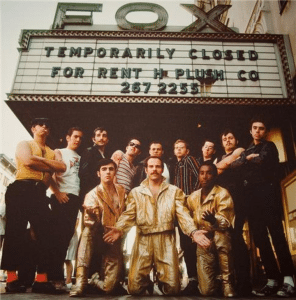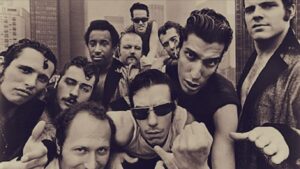The Sha-Na-Na story starts in 1969 when a group of students at Columbia University, New York, formed an acapella group called the Kingsmen. They were originally attired in turtleneck and blue blazers and performed a variety of songs, but the success of the acapella versions of 50s rock songs as part of the performances proved so popular that the rock’n’roll segment eventually took over, instruments were added and Sha Na Na was born. The name came from the refrain of the Silhouettes’ 1958 hit ‘Get a Job’.
They began playing their own folk and pop music, using oldies as filler, but they quickly noticed how audiences reacted enthusiastically to the songs from the ’50s.
Historically, the group had just two gigs a year: The Yule log lighting ceremony at Barnard College, and the mental ward at St. Luke’s Hospital.
“You were singing to older people and also to young guys who were classmates sitting in bathrobes who had a bad trip,” Greene recalls. “I will never forget having this bizarre experience having an a cappella group singing ‘Going Out of My Head’ … in a mental ward.”
Breaking out of their traditional mold, they greased back their hair, rolled up the sleeves on their T-shirts, and put on an oldies show at the campus cafeteria. People liked it so much they added costumes and instruments and called it “The Glory That Was Grease.”
The only one in the group with any formal dance training, Greene did a lot of the choreography, devising moves that could be done by guys who couldn’t dance.
“The jocks and the pukes were both coming with their hair greased back and rolled-up T-shirts, hugging and singing along to ‘Run Around Sue.”‘ Greene says. “We realized that wherever there was this kind of brotherhood, there had to be money.”
Joe Witkin, who played piano and went on to become an emergency room physician in San Diego, had the only car in the group. Alan Cooper, who sang bass and went on to teach the Bible at the Jewish Theological Seminary in New York City, joined him and they drove around Manhattan with a map of all the nightclubs. At the last one on their list, Steve Paul’s Scene, they got an audition.
“Before we could get through the first song, the guy said, ‘OK, you can start tonight. You get $50,”‘ Greene says. “We had 12 guys being paid $50.”
But the group had stepped into the perfect place at the perfect time. The club drew an extraordinary mix of promoters and stars, including Jimi Hendrix.
Their gig there lasted just two weeks, but during that time they got a record deal and bookings at Fillmore East and Woodstock.
After the movie “Woodstock” hit theaters, with Sha Na Na on screen for 52 seconds doing “Let’s Go to the Hop,” things started to change. They got booked on “The Tonight Show,” “Merv Griffin” and “David Frost.”
Instead of college girls in poodle skirts pretending to scream and swoon over them, girls were grabbing for their legs on-stage for real.
For most people at Woodstock, the big worries were rain, mud and a shortage of food. But not for John “Jocko” Marcellino. The Sha Na Na drummer and co-founder spent most of the famous 1969 rock festival wondering whether his fifties revival band would ever get to perform.
“We were supposed to go onstage on Saturday (the second day), but the schedule went out the window early,” Marcellino recalled in a telephone interview. “By Sunday we weren’t sure we would even get on.”
They finally did – just after daybreak on Monday, as the next to last act before guitarist Jimi Hendrix closed the festival. Their rave-up version of “At the Hop” turned out to be one of the highlights of the 1970 documentary film “Woodstock.”
Sha Na Na was an unlikely act amid a counterculture extravaganza that featured the likes of Janis Joplin, Santana, Jefferson Airplane and The Who, but Marcellino didn’t care. He says the appearance launched the band’s 40-year career.
“We wouldn’t have made it outside the New York area if we hadn’t played Woodstock,” he said. “We got a record deal from it. We had success in other mediums. A lot of things we did were connected to Woodstock.”
The group got there by the happenstance of a nightclub gig.
Marcellino and others had formed Sha Na Na in New York City in the spring of 1969. Marcellino, now one of only two original members still with the group, was a freshman at Columbia University then. He’d grown up in Quincy and Milton, Mass., played in a couple of local bands, and graduated from Archbishop Williams High School in Braintree, Mass.
Sha Na Na had only played six small shows before Woodstock, but they were in the right place at the right time that summer – closing night at The Scene, [IW Steve Paul’s] popular rock club in the Hell’s Kitchen area of Manhattan.
Woodstock producers Michael Lang and Artie Kornfeld were in the audience. After Sha Na Na’s set, the duo approached the band’s manager about Woodstock, and they were booked on the spot for $350.
[2020 YTcomm “Sha na Na had been the house band at Steve Paul’s Scene where Jimi discovered them, played with them, and had them invited to Woodstock to open for him.”]
2020 YTcomm *trustmeimblack1620 It was 50 years ago today – Monday, August 18, 1969. Sha Na Na were originally scheduled to play on Sunday, August 17th, and nearly didn’t get to play at all, until Jimi Hendrix intervened. He closed the festival, and said he wouldn’t set foot on the stage until they finished their set.
A few weeks later, Marcellino and his 11 bandmates made their way to a Holiday Inn near Bethel, N.Y., where other groups and singers also stayed. On Saturday, the second day of the festival, they took their U-Haul van and followed Sly and the Family Stone’s equipment truck to the backstage area.
“Then we were on our own,” Marcellino said.
Like thousands of others there, they slept on the ground or in their van, wandered back and forth to hear the headliners, and took swims in a nearby pond. By Sunday, “we started to get concerned that we weren’t going to get to rock,” Marcellino said.
Early Monday morning, after a sunrise performance by the Paul Butterfield Blues Band, they got the word they were on. They hurried out for a 30-minute set for a dwindling crowd in a trash-strewn, muddy field.
“It looked like a refugee camp,” Marcellino recalls.
Marcellino broke down his drum kit while Hendrix played. The band was back in New York later that day.
Sha Na Na has toured ever since, with multiple changes of personnel. The group had a network TV show from 1977 to 1981 and was featured in the 1978 movie “Grease.”
As it turned out, the band wound up earning nothing from Woodstock. Their check bounced. They got $1 for their subsequent appearance in the “Woodstock” film – 8 cents each for the 12-man ensemble. But no one complained. Compared to the worldwide exposure they got, “it was the greatest 8 cents we ever made,” Marcellino said.
The group’s appearance – only the eighth in Sha Na Na’s career, followed by the Woodstock album and movie, cemented their reputation and style. “We went on second to last, at sunrise on the final day, but, importantly, just before Jimi Hendrix,” recalls co-founder, drummer Jocko Marcellino. “We did 40 minutes and were paid $350…and the check bounced!” Sha Na Na was the only group at Woodstock without a record deal. Immediately afterwards, , they had one on the Kama Sutra label.
2023YTcomm *prschuster I was too much of a hippie to appreciate them in 69. Now I’m a fan.
2020 YTcomm *sabirelamhusseinschmidt9753 When I was a teen in the 90’s (and a quasi hippie) and saw this performance I thought it was cringe-worthy and out of touch with the times. 20 years later, rockabilly is my scene and I love this. I wish there was a bigger rockabilly scene where I lived in the 90’s. It was really underground then.
2021YT comm *johnf120 If an artist in 2021 came onstage and played “2011 music” it wouldn’t even seem that different. Just goes to show how much culture changed during the 60s
r their performance at Woodstock, made possible with the help of their friend Jimi Hendrix,
Sha-Na-Na 1969 at Woodstock, playing before Jimi Hendrix.
2015 *ed1cat1 To watch Sha Na Na at their absolute best with Bowzer and Johnny Contardo added (although Rob Leonard who Johnny replaced was killer) watch the Musikladen performance [IW 1973]. This was four or five years before the TV show which unfortunately most people remember them by.
www.metv.com/lists/9-greased-back-facts-about-sha-na-na
appearance as Johnny Casino and the Gamblers in Grease
Rocky Sharpe and the Replays (Razors originally) 1976
They became Rocky Sharpe and the Razors in 1978
Darts 1976 ‘Daddy Cool’ 1977 UK #6, ‘The Boy from New York City’ 1978 UK #2 (covered by the US Manhattan Transfer in 1981), ‘Duke of Earl’ 1979 UK #6
(Den Hegarty left in late 1978 to look after his ill father, featuring in three series of Jack Good’s final television show, Let’s Rock.
Flying Pickets 1982 ‘only you’
Original 1969 member, Donny York, reminisces on the beginning of Sha-na-na.


2023 YTcomm *joeroberts248 Arguably the spark that lit the fire of 50s nostalgia that would be a big part the culture for the next decade-plus.
2022 @eljefescientist5726 Pioneers of a worldwide nostalgia movement that includes American Graffiti, Grease & Fonzie, whose leather jacket is in the Smithsonian — all occurring AFTER this performance.
2015 YTcomm @robertexley1332 Rubbish. The moment the Rock n Roll ship started floating backwards
2018 YTcomm *GlobalTubeTruth2 This is embarrassing to watch. There had to be some way to get people to leave Woodstock.